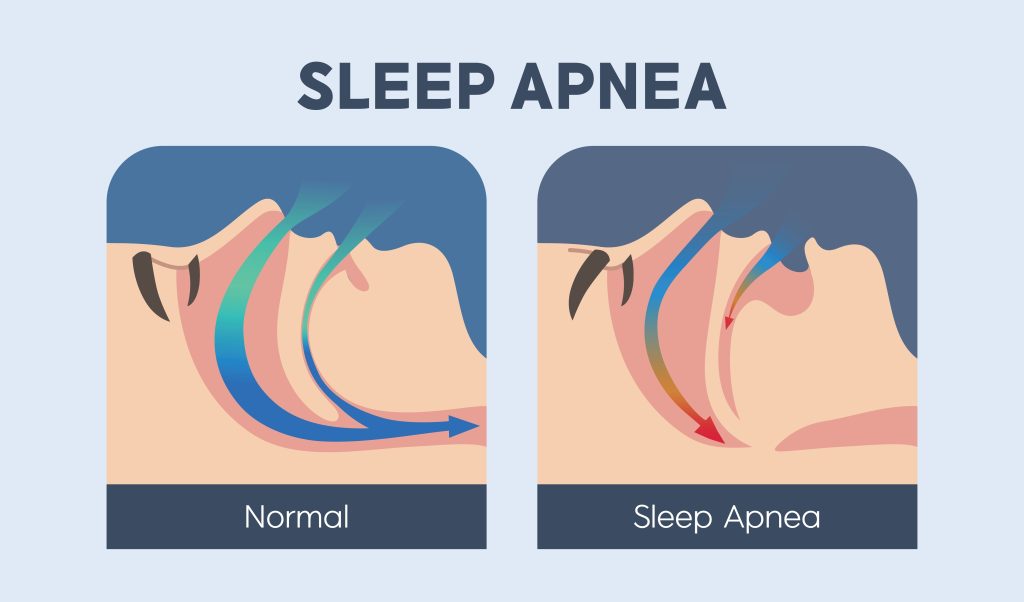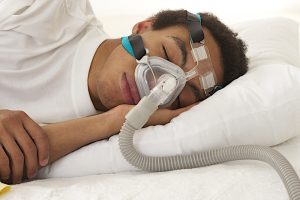Obstructive Sleep Apnea Treatment in Aventura, Pembroke Pines, and Fort Lauderdale, FL

Do You Have Obstructive Sleep Apnea?
Do you wake up every morning feeling exhausted, struggling to concentrate throughout the day, and experiencing constant irritability? These symptoms could be more than just a lack of quality sleep — they could be signs of a sleep disorder called obstructive sleep apnea (OSA).
At The Dental Care Group, we understand how debilitating sleep apnea can be. With over 50 years of experience serving South Florida families, our team is committed to helping you identify and effectively treat obstructive sleep apnea so you can enjoy restful nights and energized days.
If you’re struggling with obstructive sleep apnea, or you’re unsure if you have a sleep disorder, contact our Aventura, Pembroke Pines, or Fort Lauderdale dentists to schedule an evaluation by calling 305-935-2797 (Aventura), 954-430-2300 (Pembroke Pines), or 954-963-3706 (Fort Lauderdale).
Giving Back to Our Community
At The Dental Care Group, we’re more than just a dental practice—we’re proud members of the South Florida community. Our commitment to giving back is demonstrated through our annual Dentistry From Our Hearts event, where we provide one free day of dentistry each year to underserved families in need. This initiative reflects our belief that everyone deserves access to quality dental care, regardless of their financial circumstances.
Beyond our charitable work, we’re dedicated to serving the diverse communities of Aventura, Pembroke Pines, and Fort Lauderdale with culturally sensitive, accessible care. Our multilingual staff ensures that language is never a barrier to receiving the dental treatment you need. By combining exceptional dental expertise with genuine community care, we strive to make a positive impact on the health and well-being of every patient who walks through our doors.
What Is Obstructive Sleep Apnea?
Obstructive sleep apnea is a common sleep disorder characterized by recurrent episodes of upper airway collapse during sleep, resulting in sleep-disordered breathing and disrupted sleep. During these episodes, the muscles in your throat relax excessively, causing your airway to narrow or close completely, which prevents adequate air from getting through.
Mild sleep apnea is a less severe form of the condition, typically characterized by 5-14 breathing interruptions per hour. Moderate sleep apnea involves 15-29 interruptions per hour, while severe sleep apnea represents a more serious manifestation with 30 or more breathing pauses per hour. Having obstructive sleep apnea diagnosed is crucial for proper treatment and management.
When breathing is interrupted, your oxygen levels drop, prompting your brain to briefly wake you up so you can reopen your airway. These awakenings are usually so brief that you don’t remember them, but they severely fragment your sleep and prevent you from reaching the deep, restorative sleep stages your body needs.
Impact on Your Health
Ignoring OSA can result in major health implications. When left untreated, obstructive sleep apnea doesn’t just affect your sleep quality—it can have serious consequences for your overall health and well-being. The most common risks include:
- Heightened Risk of Cardiovascular Disease: The repeated drops in oxygen levels and the stress on your body from constant sleep disruption can lead to an increased risk of heart attack, stroke, and other cardiovascular problems.
- Hypertension: OSA is strongly linked to high blood pressure. The frequent oxygen deprivation causes your cardiovascular system to work harder, often resulting in elevated blood pressure that persists even during waking hours.
- Cognitive Impairment: Chronic sleep deprivation from OSA can affect memory, concentration, decision-making abilities, and overall cognitive function. Many patients report “brain fog” and difficulty focusing on tasks.
- Accidents Stemming from Excessive Daytime Sleepiness: The fatigue caused by OSA significantly increases the risk of motor vehicle accidents and workplace injuries due to impaired alertness and slower reaction times.
- Metabolic Disorders: OSA has been linked to insulin resistance, type 2 diabetes, and metabolic syndrome.
- Mood Disorders: Depression, anxiety, and irritability are common among individuals with untreated sleep apnea.
- Reduced Quality of Life: The cumulative effects of poor sleep can impact relationships, work performance, and overall life satisfaction.
Symptoms of Obstructive Sleep Apnea
Symptoms of OSA can show differently during nighttime and daytime, making it important to recognize both patterns.
Nighttime Symptoms
The nighttime symptoms of obstructive sleep apnea include:
 Loud Snoring: Often the most noticeable symptom, though not everyone who snores has sleep apnea
Loud Snoring: Often the most noticeable symptom, though not everyone who snores has sleep apnea- Gasping: Sudden gasps for air during sleep
- Choking: Sensations of choking that may wake you up
- Witnessed Pauses in Breathing During Sleep: Often observed by bed partners who notice periods where breathing stops
- Recurrent Limb Movements During Sleep: Restless movements or twitching during the night
- The Feeling of Tiredness or Exhaustion Upon Awakening: Waking up feeling unrefreshed despite spending adequate time in bed
These symptoms can disrupt not only the individual’s sleep but also the sleep of their bed partner. If you or your bed partner notice any of these symptoms, especially when trying to fall asleep, seek medical assistance for proper evaluation and diagnosis.
Daytime Symptoms
During the day, individuals with obstructive sleep apnea may experience the following symptoms:
 Excessive Sleepiness: Overwhelming urge to sleep during the day, even after a full night in bed
Excessive Sleepiness: Overwhelming urge to sleep during the day, even after a full night in bed- Morning Headaches: Frequent headaches upon waking, often due to oxygen deprivation
- Irritability: Mood changes and increased frustration or impatience
- Difficulty Concentrating: Problems with focus, memory, and mental clarity
- Depression: Persistent feelings of sadness or hopelessness
These symptoms can have a considerable effect on a person’s quality of life, affecting work performance, social interactions, and overall well-being. Many people don’t realize that their daytime symptoms are connected to their nighttime breathing problems.
OSA Causes and Risk Factors
Obstructive sleep apnea can have various causes and risk factors. Understanding these can help you assess your risk and take proactive steps toward diagnosis and treatment:
- Obesity: One of the most significant risk factors for OSA is obesity. Excess fat in the neck and throat can put pressure on the airway, making it more likely to collapse during sleep. Even moderate weight loss can significantly improve sleep apnea symptoms.
- Neck Circumference: Individuals with a larger neck circumference are at higher risk, as a thicker neck may have a narrower airway. Generally, a neck circumference greater than 17 inches in men or 16 inches in women indicates increased risk.
- Gender: Men are more likely to develop OSA than women, although the risk for women increases if they’re overweight or after menopause.
- Age: OSA is more common in middle-aged and older adults. However, it can occur at any age, including in children, particularly those with enlarged tonsils and adenoids.
- Family History: There is evidence to suggest that OSA can run in families, indicating a genetic component. If you have family members with sleep apnea, you may be at increased risk.
- Smoking: Smoking can increase inflammation and fluid retention in the upper airway, making it more susceptible to obstruction. Smokers are three times more likely to have OSA than people who’ve never smoked.
- Alcohol and Sedative Use: The relaxation of throat muscles due to alcohol or sedative use can increase the likelihood of airway collapse during sleep. It’s best to avoid these substances, especially in the hours before bedtime.
- Nasal Congestion: Chronic nasal congestion or a deviated septum can make it harder to breathe through the nose, leading to increased reliance on mouth breathing, which can contribute to OSA.
- Medical Conditions: Certain medical conditions, such as hypothyroidism, acromegaly, and polycystic ovary syndrome (PCOS), have been associated with an increased risk of OSA.
- Enlarged Tonsils and Adenoids: In children, enlarged tonsils and adenoids can obstruct the airway and lead to OSA. This is one of the most common causes of pediatric sleep apnea.
- Craniofacial Abnormalities: Structural abnormalities in the face and skull can affect the size and shape of the airway, increasing the risk of obstruction. These may include a small jaw, a large tongue, or other anatomical variations.
- Gastroesophageal Reflux Disease (GERD): The association between GERD and OSA is complex, but GERD can exacerbate OSA and vice versa, creating a cycle that worsens both conditions.
- Menopause: Postmenopausal women may have an increased risk of OSA due to hormonal changes and weight gain.
Diagnosing Obstructive Sleep Apnea
Consultation and Medical History
During a consultation for OSA at The Dental Care Group, we’ll conduct an initial evaluation to assess your risk factors and symptoms. We’ll discuss your sleep patterns, daytime symptoms, medical history, medications, and lifestyle factors that may contribute to sleep apnea.
Physical Examination
A thorough examination of the throat, neck, and mouth is performed to identify any anatomical factors that may contribute to sleep apnea, such as enlarged tonsils, a narrow airway, or excess tissue in the throat.
Sleep Questionnaires
You may be asked to complete questionnaires such as the Epworth Sleepiness Scale to assess your level of daytime sleepiness and other symptom indicators. If we believe you may be suffering from sleep apnea based on this initial evaluation, we’ll refer you to a sleep specialist for a comprehensive sleep study.
Sleep Studies
Sleep studies are conducted either in a specialized laboratory or at home using a portable monitor, which is considered the most reliable approach for diagnosing obstructive sleep apnea, as it measures breathing disruptions during sleep.
During a sleep study (polysomnography), the following are monitored:
- Respiration: Breathing patterns, including pauses and shallow breathing
- Motor Activity: Body movements and limb activity during sleep
- Cardiac Rate: Heart rate and rhythm throughout the night
- Oxygen Levels: Blood oxygen saturation to detect drops during apnea episodes
- Brain Activity: Sleep stages and arousal patterns
- Time Taken to Enter Different Stages of Sleep: Assessment of sleep quality and architecture
The results of your sleep study will provide detailed information about the frequency and severity of your breathing interruptions, allowing for accurate diagnosis and treatment planning.
Return Visit for Treatment Planning
After a confirmed diagnosis, you’ll return to our dental office in Aventura, Pembroke Pines, or Fort Lauderdale, where we’ll go over your treatment options. We’ll review your sleep study results, discuss the severity of your condition, and create a personalized treatment plan tailored to your specific needs and preferences.
Treatment Options for OSA
At The Dental Care Group, we offer comprehensive treatment options for obstructive sleep apnea. The right treatment for you depends on the severity of your condition, your anatomy, lifestyle factors, and personal preferences.
Lifestyle Changes
Lifestyle changes can play a significant role in alleviating OSA symptoms. Changes that may be recommended include:
- Weight Loss: Reducing weight has been observed to reduce the intensity of obstructive sleep apnea, particularly for individuals who are overweight or obese. Even a 10% reduction in body weight can significantly improve symptoms.
- Abstaining from Alcohol and Sedatives: These substances can relax the muscles of the upper airway and exacerbate OSA symptoms. Avoiding them, especially in the hours before bedtime, can help reduce symptom severity.
- Practicing Good Sleep Hygiene: Maintaining a consistent sleep schedule and creating a sleep-conducive environment can improve sleep quality and reduce the severity of OSA symptoms. This includes keeping your bedroom dark, quiet, and cool, and establishing a relaxing bedtime routine.
- Positional Therapy: Some people experience worse sleep apnea when sleeping on their backs. Sleeping on your side can help keep the airway open and reduce apnea events.
- Smoking Cessation: If you smoke, quitting can reduce inflammation and fluid retention in the upper airway, potentially improving your symptoms.
CPAP Therapy
 Continuous positive airway pressure (CPAP) therapy is the most effective treatment for severe obstructive sleep apnea. CPAP involves the delivery of pressurized air through a bedside machine and into the nose and/or mouth via a mask to maintain the airway open during sleep.
Continuous positive airway pressure (CPAP) therapy is the most effective treatment for severe obstructive sleep apnea. CPAP involves the delivery of pressurized air through a bedside machine and into the nose and/or mouth via a mask to maintain the airway open during sleep.
Regular use of CPAP for moderate to severe sleep apnea has been shown to significantly improve cognitive function and general health status, and reduce the risk of cardiovascular complications. While CPAP is highly effective, some patients find it uncomfortable or difficult to tolerate, which is where alternative treatments become valuable.
Oral Appliances
 Oral appliances are another effective treatment option for OSA, particularly for mild obstructive sleep apnea or for patients who cannot tolerate CPAP therapy. At The Dental Care Group, we specialize in custom-fitted oral appliances that are designed to maintain the position of the jaw and tongue, reducing the pressure on the windpipe.
Oral appliances are another effective treatment option for OSA, particularly for mild obstructive sleep apnea or for patients who cannot tolerate CPAP therapy. At The Dental Care Group, we specialize in custom-fitted oral appliances that are designed to maintain the position of the jaw and tongue, reducing the pressure on the windpipe.
These specialized mouthpieces, such as mandibular advancement devices (MADs), gently reposition the lower jaw forward, which helps keep the airway open during sleep. Our dentists will take precise impressions of your teeth to create a custom appliance that fits comfortably and effectively treats your sleep apnea.
Benefits of oral appliances include:
- More comfortable and portable than CPAP machines
- Easier to travel with
- No electricity required
- Quieter than CPAP
- Higher compliance rates for many patients
Mouth and Throat Exercises
Mouth and throat exercises can be a useful complement to other treatments for mild cases of obstructive sleep apnea. These exercises aim to strengthen the muscles in the mouth and throat, potentially reducing the severity of sleep apnea symptoms. However, these exercises may not be a standalone solution for moderate to severe OSA.
Surgery
Surgical interventions, such as uvulopalatopharyngoplasty (UPPP), genioglossus advancement (GA), or even a tracheostomy, can be considered for severe cases of OSA or when other treatments have failed. However, this is the rarest treatment option as it’s the most invasive.
Surgical options may also include:
- Tonsillectomy and Adenoidectomy: Particularly effective for children with enlarged tonsils and adenoids
- Nasal Surgery: To correct structural problems like a deviated septum
- Jaw Surgery: To reposition the jaw and enlarge the airway in cases with specific anatomical issues
Surgery is typically considered only after other treatment options have been explored and when the benefits outweigh the risks.
Frequently Asked Questions
What causes obstructive sleep apnea?
Obstructive sleep apnea is caused by a blockage of the airway due to several factors, such as being overweight or obese, having large tonsils, anatomical variations in the throat or jaw, or changes in hormone levels. The common thread is that something causes the throat muscles to relax too much during sleep, allowing the airway to narrow or close.
Can you fix obstructive sleep apnea?
Although obstructive sleep apnea is usually not curable, treatment can effectively assist the majority of individuals in reducing breathing interruptions, enhancing sleep quality, and mitigating health-related repercussions. With proper treatment and lifestyle modifications, most people with OSA can manage their symptoms successfully and enjoy significantly improved quality of life.
What is the difference between obstructive sleep apnea and central sleep apnea?
Obstructive sleep apnea (OSA) is characterized by a physical blockage or collapse of the upper airway during sleep, leading to repeated interruptions in breathing. Central sleep apnea (CSA) is a neurological condition where the brain fails to send proper signals to the muscles that control breathing, causing pauses in breathing without physical airway obstruction. OSA is much more common than CSA.
How long does it take to see improvement with treatment?
Many patients notice improvements in their symptoms within the first few weeks of starting treatment. However, the full benefits of treatment, including reduced cardiovascular risk and improved cognitive function, may take several months to fully manifest. Consistency with your treatment plan is key to achieving optimal results.
Will I need treatment for the rest of my life?
For most people, OSA is a chronic condition that requires ongoing management. However, significant weight loss or other lifestyle changes may reduce or even eliminate the need for treatment in some cases. Your treatment needs should be regularly reassessed through follow-up appointments and, if necessary, repeat sleep studies.
2797 NE 207th Street, Suite 100 Aventura, FL 33180 | (305) 935-2797
12634 Pines Blvd. Pembroke Pines, FL 33027 | (954) 430-2300
3107 Stirling Rd #108 Fort Lauderdale, FL 33027 | (954) 963-3706
Get the Treatment You Need for Sleep Disorders
Obstructive sleep apnea is a prevalent and potentially severe sleep disorder that affects a significant portion of the global population. If you’re struggling to find a treatment that works best for you, contact our dentists in Aventura, Pembroke Pines, or Fort Lauderdale today. Call us at 305-935-2797 (Aventura), 954-430-2300 (Pembroke Pines), or 954-963-3706 (Fort Lauderdale). We’ll set up your appointment and help you on the path to better sleep and better health. With over 50 years of experience and a commitment to patient-centric care, The Dental Care Group is here to help you reclaim the restful sleep you deserve.

